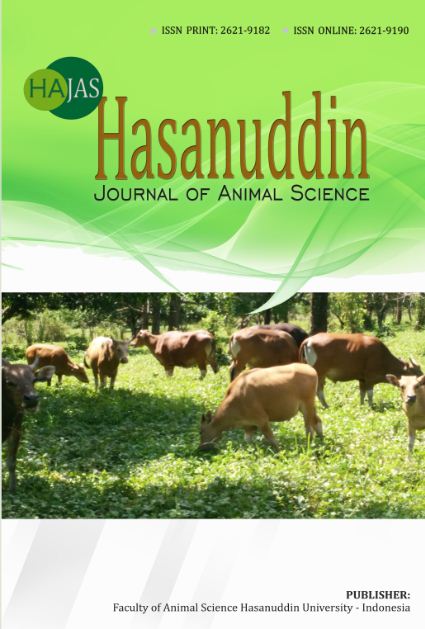This is an outdated version published on 2024-01-26. Read the most recent version.
Characterization of Potential Analysis and Biodiversity of Grassland
DOI:
https://doi.org/10.20956/hajas.v5i2.27600Abstract
This study aimed to determine forage availability on pastures by analyzing pastures' forage quality and evaluating pastures' biodiversity in Tanete Riaja District, Barru Regency. The results of this study indicated that the botanical composition (BC) in the Tanete Riaja District was shallow because weeds still dominate the pasture in this area by 60%. The biodiversity richness index (BRI) in the pasture of Tanete Riaja District was found in grass species with a margalef index (MI) of 3.09 and in legume species with an MI of 1.21. In contrast, the grass species' diversity index value (DI) was 0.29 Shannon-Weiner index (SWI), and the legume species was 0.36 SWI. The value DI on grass and legume species was classified in the low category. At the research location, there was 0.22 tons/ha of total forage production, while forage livestock could eat 0.15 tons/ha. The results obtained in this study indicated that the carrying capacity or pasture capacity of the natural pasture (NF) area was 0.06 UT/Ha, which was classified as heavy pasture. The results of this study indicated that the percentage of pasture forage in Tanete Riaja, Barru Regency, was dominated by weeds at 37.61%, grass at 48.35%, and legumes at 14.04%. The CC of the pasture area was 0.4 ST / Ha / Year, which is classified as heavy pasture. Keywords: Carrying Capacity, Rumination, Forage, Biodiversity, GrassDownloads
Download data is not yet available.
Downloads
Published
2024-01-21 — Updated on 2024-01-26
Versions
- 2024-02-06 (3)
- 2024-01-26 (2)
- 2024-01-21 (1)
Issue
Section
Articles
License

This work is licensed under a Creative Commons Attribution-NonCommercial 4.0 International License.










